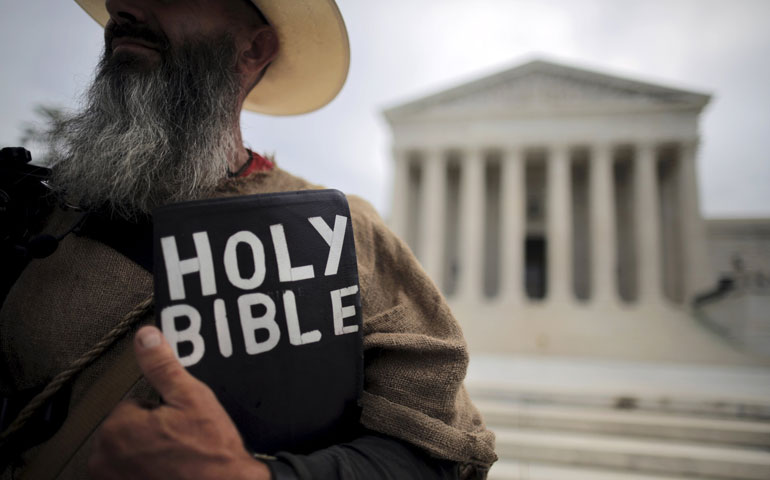
A protester holds a copy of the Bible outside of the U.S. Supreme Court building in Washington June 15. The court June 18, 2015, ruled that a town in Arizona violated a local church’s free speech rights by preventing it from posting signs notifying the public of its worship services. (CNS/Reuters/Carlos Barria)
 FREE SPEECH: TEN PRINCIPLES FOR A CONNECTED WORLD
FREE SPEECH: TEN PRINCIPLES FOR A CONNECTED WORLD
By Timothy Garton Ash
Published by Yale University Press, 504 pages, $30
Timothy Garton Ash, an Oxford professor and director of freespeechdebate.com, presents a tall order in Free Speech: Ten Principles for a Connected World. He argues for more and better speech. The biggest problem the world faces, he says, is how to agree to disagree.
Garton Ash begins with his ending. The world is overconnected by social media, yet precious little discussion occurs. Rather, verbal brickbats fly in every direction, some acknowledged, many ignored, and one or two actually meaningful. The problem is the very connectivity that allows free speech, and tugging one thread affects the entire tapestry.
So Garton Ash offers 10 principles to handle the mishmash of information, policy statements, entertainment and outright lies flooding the world of public conversation. Before presenting his principles, however, he offers a breezy, magazine-like look at how information and misinformation wend their way through the public mind. Within hundreds of anecdotes, he embeds support for his argument that everyone can and should have a voice. He recommends citizens and “netizens” wield influence through nongovernmental organizations, through involvement in online platforms, and by creation of virtual communities. Many of his observations recommend well-tried public relations strategies, all aimed at influencing policy.
The second part of the book lays out his 10 principles, which seem aimed at calming cacophony and allowing the freest possible speech and debate -- within limits. The ongoing question, of course, is who sets the limits and who monitors them.
The 10 chapter headings and principals are: Lifeblood (we must be able to express ourselves); Violence (we neither threaten nor accept violent intimidation); Knowledge (we allow knowledge to spread); Journalism (we allow uncensored media); Diversity (we allow open and civil expression of all human difference); Religion (we respect the believer but not necessarily the content of the belief); Privacy (we must protect both privacy and against slurs, but also protect scrutiny in the public interest); Secrecy (we must challenge all national security limits placed on information); Icebergs (we defend the free internet); and Courage (we decide for ourselves and face the consequences).
The bulk of Garton Ash’s annoyingly breezy discussion of his 10 principles supports a totally free information environment. His discussion of religion gives example. He calls it astonishing that many European countries maintain blasphemy penal codes and writes: “A practical reason for offering religion special treatment might therefore be that a large part of humankind apparently believes that it deserves it.” The discussion might end there, but he qualifies and then seems to argue against the protection of religious statements and beliefs.
He concludes that while tolerance is necessary, there must be a balance between unconditional respect for the believer and what may be “a total lack of appraisal respect for the content of the belief.” If that is a compromise, he writes, the polity must be uncompromising about it.
He does not account for political choices based in -- or dismissed because of -- religious belief. As such, he essentially ignores the question of genuine religious freedom, entwined as it is amid accepted practices, cultural mores and common ethical beliefs.
Here is the danger of Garton Ash’s discussion. The double diamond slope of tolerance goes only so far in civil society before it goes over the edge. Only so far, that is, unless you believe that laissez faire can and should replace all limits on speech and, ultimately, on policy. The inference is that if your religion supports your policy choice, your “personal belief” may be tolerated, but not necessarily acted upon or respected because it lives in the private -- albeit protected -- realm. No one will force you to overcome your belief, but neither can your belief overcome another’s disregard of the same.
Pick an issue -- from burkinis to abortion -- and you can easily see the collision between “personal choice” and what society will force a decision for or against, irrespective of your (or the majority’s) belief systems.
Here, Garton Ash, writing in the European context, perhaps unwittingly maps the ways social media is erasing the normative religious and cultural differences in the European Union. For the American reading public, he does not strike the crucial balance between the First and the 14th Amendments to the U.S. Constitution. While the First protects the free speech privileges of citizens, the 14th protects their immunities.
It is the immunities that should be protected, whether immunity from violent speech and libel, from invasion of privacy and disrespect of religious understandings, and from unbridled censorship. But we must equally be protected from the tide of misinformation, disinformation and outright abuse of the privileges of free speech that have turned social media into a sewer.
[Phyllis Zagano is senior research associate-in-residence at Hofstra University. Her books include Women Deacons?: Essays with Answers and In the Image of Christ: Essays on Being Catholic and Female.]



